seats KIA Optima 2007 2.G Owner's Manual
[x] Cancel search | Manufacturer: KIA, Model Year: 2007, Model line: Optima, Model: KIA Optima 2007 2.GPages: 294, PDF Size: 3.37 MB
Page 20 of 294
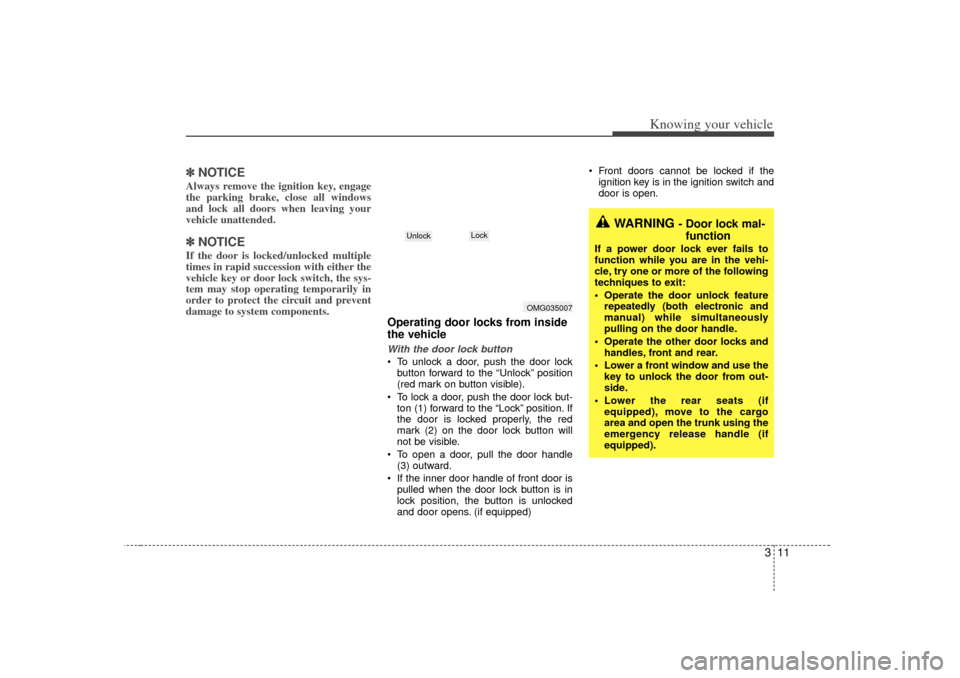
311
Knowing your vehicle
✽
✽NOTICEAlways remove the ignition key, engage
the parking brake, close all windows
and lock all doors when leaving your
vehicle unattended. ✽ ✽NOTICEIf the door is locked/unlocked multiple
times in rapid succession with either the
vehicle key or door lock switch, the sys-
tem may stop operating temporarily in
order to protect the circuit and prevent
damage to system components.
Operating door locks from inside
the vehicleWith the door lock button To unlock a door, push the door lock
button forward to the “Unlock” position
(red mark on button visible).
To lock a door, push the door lock but- ton (1) forward to the “Lock” position. If
the door is locked properly, the red
mark (2) on the door lock button will
not be visible.
To open a door, pull the door handle (3) outward.
If the inner door handle of front door is pulled when the door lock button is in
lock position, the button is unlocked
and door opens. (if equipped) Front doors cannot be locked if the
ignition key is in the ignition switch and
door is open.
WARNING
- Door lock mal-function
If a power door lock ever fails to
function while you are in the vehi-
cle, try one or more of the following
techniques to exit:
• Operate the door unlock feature
repeatedly (both electronic and
manual) while simultaneously
pulling on the door handle.
Operate the other door locks and handles, front and rear.
Lower a front window and use the key to unlock the door from out-
side.
Lower the rear seats (if equipped), move to the cargo
area and open the trunk using the
emergency release handle (if
equipped).
OMG035007
Lock
Unlock
Page 28 of 294
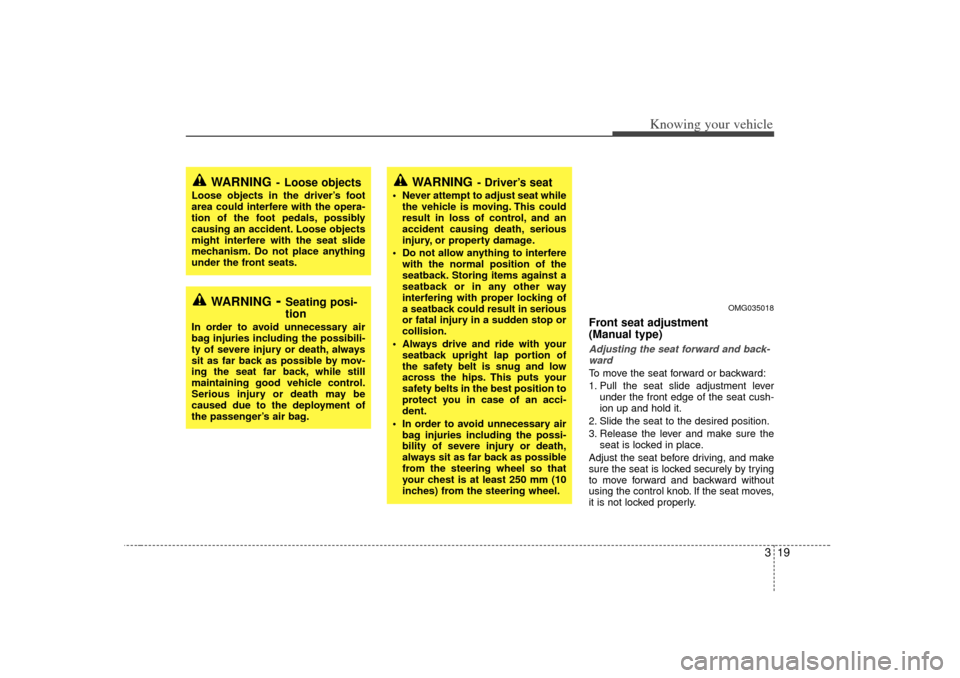
319
Knowing your vehicle
Front seat adjustment
(Manual type)Adjusting the seat forward and back-wardTo move the seat forward or backward:
1. Pull the seat slide adjustment lever under the front edge of the seat cush-
ion up and hold it.
2. Slide the seat to the desired position.
3. Release the lever and make sure the seat is locked in place.
Adjust the seat before driving, and make
sure the seat is locked securely by trying
to move forward and backward without
using the control knob. If the seat moves,
it is not locked properly.
WARNING
- Loose objects
Loose objects in the driver’s foot
area could interfere with the opera-
tion of the foot pedals, possibly
causing an accident. Loose objects
might interfere with the seat slide
mechanism. Do not place anything
under the front seats.
WARNING
- Seating posi-
tion
In order to avoid unnecessary air
bag injuries including the possibili-
ty of severe injury or death, always
sit as far back as possible by mov-
ing the seat far back, while still
maintaining good vehicle control.
Serious injury or death may be
caused due to the deployment of
the passenger’s air bag.
WARNING
- Driver’s seat
Never attempt to adjust seat while the vehicle is moving. This could
result in loss of control, and an
accident causing death, serious
injury, or property damage.
Do not allow anything to interfere with the normal position of the
seatback. Storing items against a
seatback or in any other way
interfering with proper locking of
a seatback could result in serious
or fatal injury in a sudden stop or
collision.
Always drive and ride with your seatback upright lap portion of
the safety belt is snug and low
across the hips. This puts your
safety belts in the best position to
protect you in case of an acci-
dent.
In order to avoid unnecessary air bag injuries including the possi-
bility of severe injury or death,
always sit as far back as possible
from the steering wheel so that
your chest is at least 250 mm (10
inches) from the steering wheel.
OMG035018
Page 30 of 294
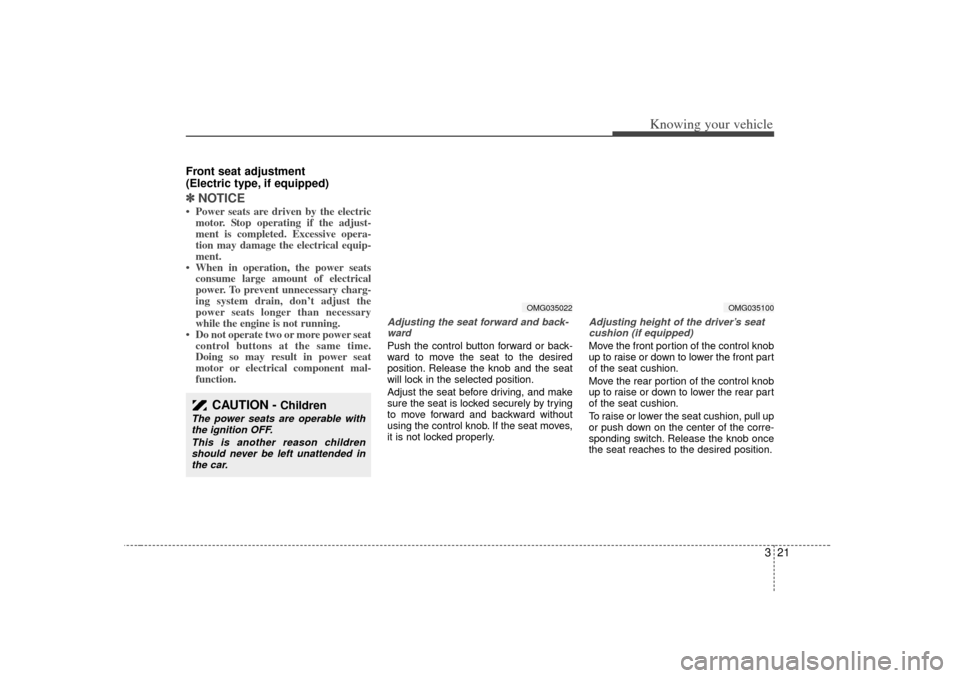
321
Knowing your vehicle
Front seat adjustment
(Electric type, if equipped)✽ ✽NOTICE• Power seats are driven by the electric
motor. Stop operating if the adjust-
ment is completed. Excessive opera-
tion may damage the electrical equip-
ment.
• When in operation, the power seats consume large amount of electrical
power. To prevent unnecessary charg-
ing system drain, don’t adjust the
power seats longer than necessary
while the engine is not running.
• Do not operate two or more power seat control buttons at the same time.
Doing so may result in power seat
motor or electrical component mal-
function.
Adjusting the seat forward and back-
wardPush the control button forward or back-
ward to move the seat to the desired
position. Release the knob and the seat
will lock in the selected position.
Adjust the seat before driving, and make
sure the seat is locked securely by trying
to move forward and backward without
using the control knob. If the seat moves,
it is not locked properly.
Adjusting height of the driver’s seatcushion (if equipped)Move the front portion of the control knob
up to raise or down to lower the front part
of the seat cushion.
Move the rear portion of the control knob
up to raise or down to lower the rear part
of the seat cushion.
To raise or lower the seat cushion, pull up
or push down on the center of the corre-
sponding switch. Release the knob once
the seat reaches to the desired position.
CAUTION -
Children
The power seats are operable with the ignition OFF.
This is another reason childrenshould never be left unattended inthe car.
OMG035022
OMG035100
Page 31 of 294

Knowing your vehicle22
3Adjusting the seatback reclinerMove the lever forward or backward to
the desired angle and release the lever. If
the lever is released, seatback will lock in
place. After adjustment, make sure that
the lever has returned to its original
locked position.
Warming the front seat
(if equipped)The front seats can be electrically heated
individually when the ignition switch is
ON. When the switch is ON, a number
ranging from 1 to 5 is displayed on the
switch (5 = warmest setting).
To turn off the seat warmer, set the
switch to 0.
The seat warmer turns off automatically
when the seat temperature reaches the
selected range and will turn on again if
the temperature drops below the select-
ed range.
OMG035023
WARNING
- Driver respon-
sibility for front seat pas-
senger
Driving or riding in a vehicle with a
front seatback reclined could lead
to serious or fatal injury in an acci-
dent. If a front seat is reclined dur-
ing an accident, the occupant’s hips
may slide under the lap portion of
the safety belt applying great force
to the unprotected abdomen or
neck. Serious or fatal internal
injuries could result. The driver
must advise the front passenger to
keep the seatbacks in comfortably
upright position whenever the vehi-
cle is in motion.
OMG035024
Page 32 of 294
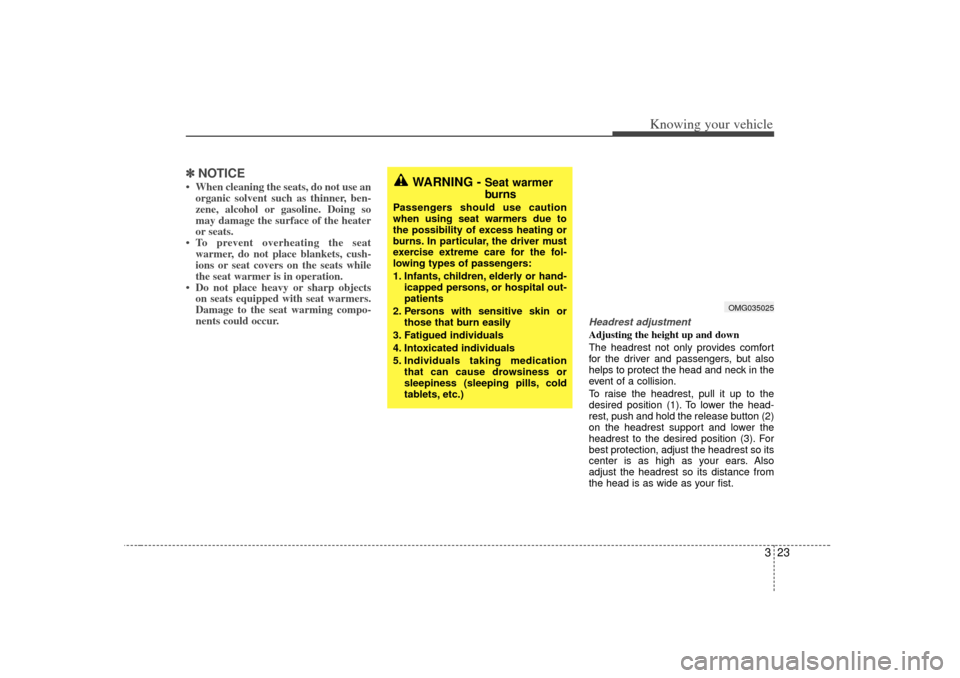
323
Knowing your vehicle
✽
✽NOTICE• When cleaning the seats, do not use an
organic solvent such as thinner, ben-
zene, alcohol or gasoline. Doing so
may damage the surface of the heater
or seats.
• To prevent overheating the seat warmer, do not place blankets, cush-
ions or seat covers on the seats while
the seat warmer is in operation.
• Do not place heavy or sharp objects on seats equipped with seat warmers.
Damage to the seat warming compo-
nents could occur.
Headrest adjustmentAdjusting the height up and down
The headrest not only provides comfort
for the driver and passengers, but also
helps to protect the head and neck in the
event of a collision.
To raise the headrest, pull it up to the
desired position (1). To lower the head-
rest, push and hold the release button (2)
on the headrest support and lower the
headrest to the desired position (3). For
best protection, adjust the headrest so its
center is as high as your ears. Also
adjust the headrest so its distance from
the head is as wide as your fist.
WARNING -
Seat warmer
burns
Passengers should use caution
when using seat warmers due to
the possibility of excess heating or
burns. In particular, the driver must
exercise extreme care for the fol-
lowing types of passengers:
1. Infants, children, elderly or hand-
icapped persons, or hospital out-
patients
2. Persons with sensitive skin or those that burn easily
3. Fatigued individuals
4. Intoxicated individuals
5. Individuals taking medication that can cause drowsiness or
sleepiness (sleeping pills, cold
tablets, etc.)
OMG035025
Page 35 of 294
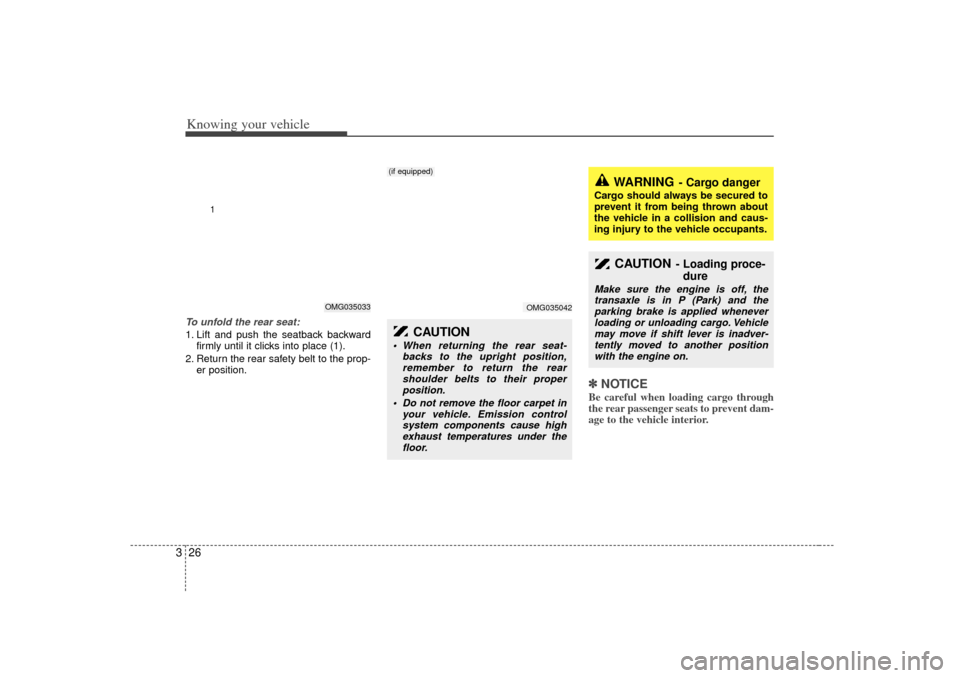
Knowing your vehicle26
3To unfold the rear seat:1. Lift and push the seatback backward
firmly until it clicks into place (1).
2. Return the rear safety belt to the prop- er position.
✽
✽NOTICEBe careful when loading cargo through
the rear passenger seats to prevent dam-
age to the vehicle interior.
OMG035033
1
OMG035042
(if equipped)
CAUTION
When returning the rear seat-
backs to the upright position,remember to return the rear shoulder belts to their properposition.
Do not remove the floor carpet in your vehicle. Emission controlsystem components cause highexhaust temperatures under thefloor.
WARNING
- Cargo danger
Cargo should always be secured to
prevent it from being thrown about
the vehicle in a collision and caus-
ing injury to the vehicle occupants.
CAUTION
- Loading proce- dure
Make sure the engine is off, the
transaxle is in P (Park) and the parking brake is applied wheneverloading or unloading cargo. Vehicle may move if shift lever is inadver-tently moved to another positionwith the engine on.
Page 37 of 294
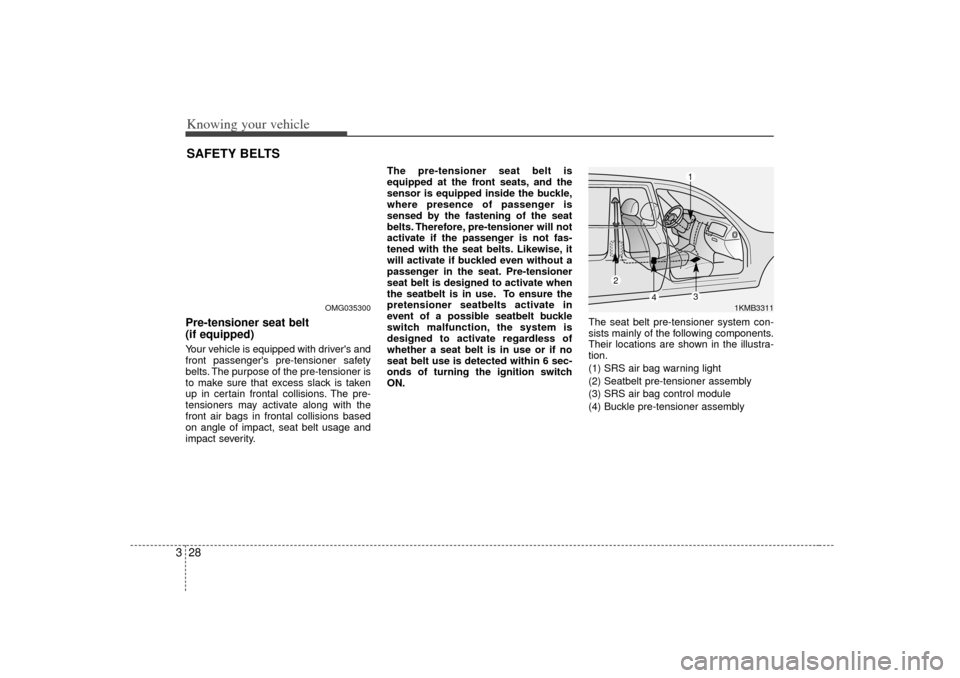
Knowing your vehicle28
3Pre-tensioner seat belt
(if equipped)Your vehicle is equipped with driver's and
front passenger's pre-tensioner safety
belts. The purpose of the pre-tensioner is
to make sure that excess slack is taken
up in certain frontal collisions. The pre-
tensioners may activate along with the
front air bags in frontal collisions based
on angle of impact, seat belt usage and
impact severity. The pre-tensioner seat belt is
equipped at the front seats, and the
sensor is equipped inside the buckle,
where presence of passenger is
sensed by the fastening of the seat
belts. Therefore, pre-tensioner will not
activate if the passenger is not fas-
tened with the seat belts. Likewise, it
will activate if buckled even without a
passenger in the seat. Pre-tensioner
seat belt is designed to activate when
the seatbelt is in use. To ensure the
pretensioner seatbelts activate in
event of a possible seatbelt buckle
switch malfunction, the system is
designed to activate regardless of
whether a seat belt is in use or if no
seat belt use is detected within 6 sec-
onds of turning the ignition switch
ON.
The seat belt pre-tensioner system con-
sists mainly of the following components.
Their locations are shown in the illustra-
tion.
(1) SRS air bag warning light
(2) Seatbelt pre-tensioner assembly
(3) SRS air bag control module
(4) Buckle pre-tensioner assemblySAFETY BELTS
1KMB3311
1
2
3
4
OMG035300
Page 39 of 294
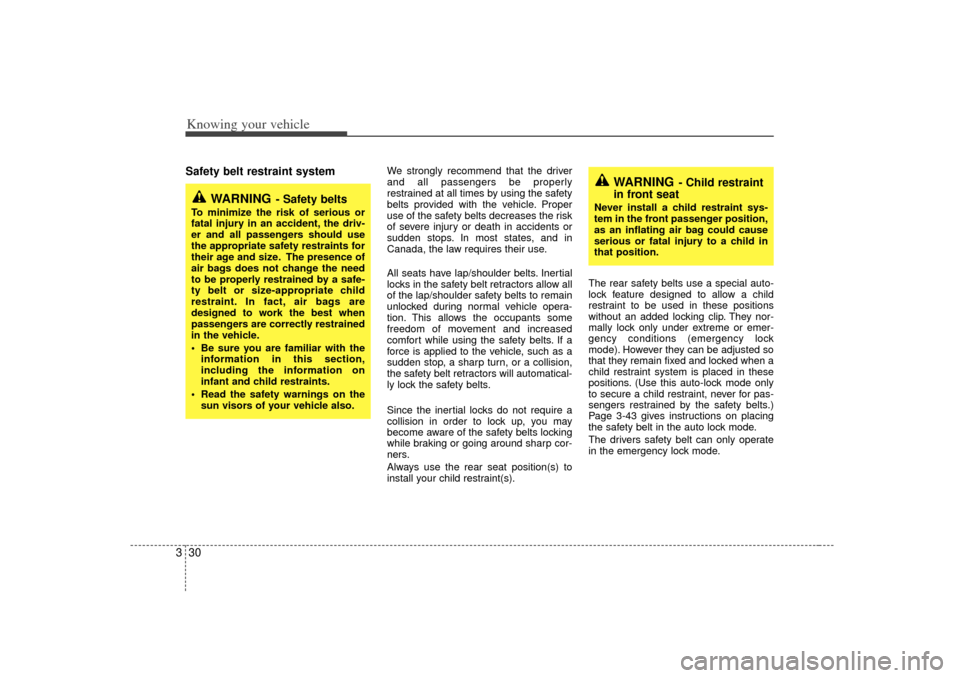
Knowing your vehicle30
3Safety belt restraint system
We strongly recommend that the driver
and all passengers be properly
restrained at all times by using the safety
belts provided with the vehicle. Proper
use of the safety belts decreases the risk
of severe injury or death in accidents or
sudden stops. In most states, and in
Canada, the law requires their use.
All seats have lap/shoulder belts. Inertial
locks in the safety belt retractors allow all
of the lap/shoulder safety belts to remain
unlocked during normal vehicle opera-
tion. This allows the occupants some
freedom of movement and increased
comfort while using the safety belts. If a
force is applied to the vehicle, such as a
sudden stop, a sharp turn, or a collision,
the safety belt retractors will automatical-
ly lock the safety belts.
Since the inertial locks do not require a
collision in order to lock up, you may
become aware of the safety belts locking
while braking or going around sharp cor-
ners.
Always use the rear seat position(s) to
install your child restraint(s). The rear safety belts use a special auto-
lock feature designed to allow a child
restraint to be used in these positions
without an added locking clip. They nor-
mally lock only under extreme or emer-
gency conditions (emergency lock
mode). However they can be adjusted so
that they remain fixed and locked when a
child restraint system is placed in these
positions. (Use this auto-lock mode only
to secure a child restraint, never for pas-
sengers restrained by the safety belts.)
Page 3-43 gives instructions on placing
the safety belt in the auto lock mode.
The drivers safety belt can only operate
in the emergency lock mode.
WARNING
- Safety belts
To minimize the risk of serious or
fatal injury in an accident, the driv-
er and all passengers should use
the appropriate safety restraints for
their age and size. The presence of
air bags does not change the need
to be properly restrained by a safe-
ty belt or size-appropriate child
restraint. In fact, air bags are
designed to work the best when
passengers are correctly restrained
in the vehicle.
Be sure you are familiar with the
information in this section,
including the information on
infant and child restraints.
Read the safety warnings on the sun visors of your vehicle also.
WARNING
- Child restraint
in front seat
Never install a child restraint sys-
tem in the front passenger position,
as an inflating air bag could cause
serious or fatal injury to a child in
that position.
Page 45 of 294
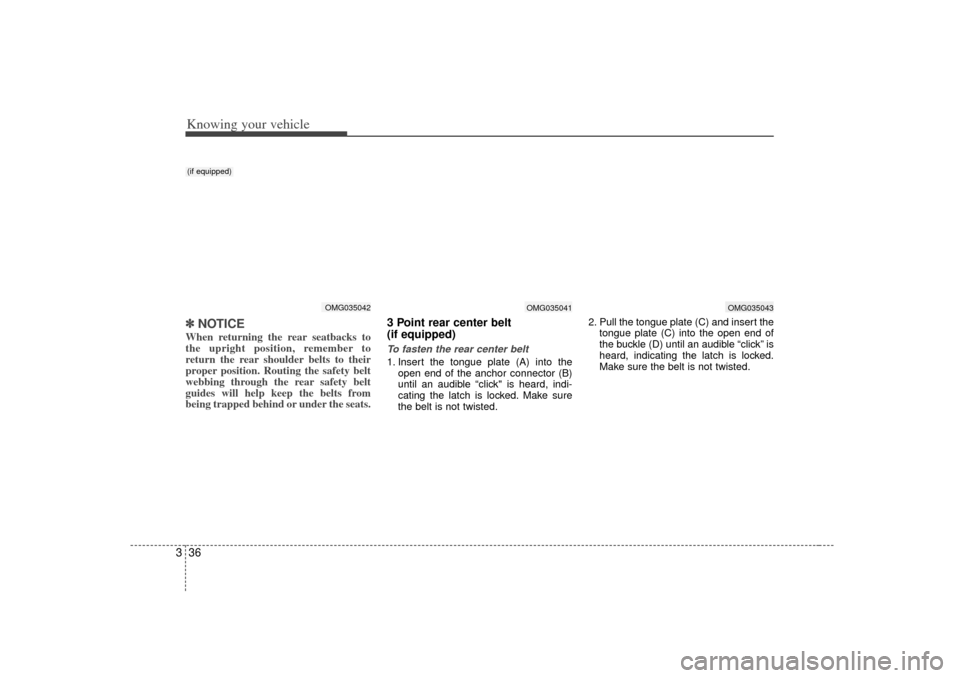
Knowing your vehicle36
3✽
✽
NOTICEWhen returning the rear seatbacks to
the upright position, remember to
return the rear shoulder belts to their
proper position. Routing the safety belt
webbing through the rear safety belt
guides will help keep the belts from
being trapped behind or under the seats.
3 Point rear center belt
(if equipped) To fasten the rear center belt1. Insert the tongue plate (A) into the
open end of the anchor connector (B)
until an audible “click" is heard, indi-
cating the latch is locked. Make sure
the belt is not twisted. 2. Pull the tongue plate (C) and insert the
tongue plate (C) into the open end of
the buckle (D) until an audible “click”is
heard, indicating the latch is locked.
Make sure the belt is not twisted.
OMG035042
(if equipped)
OMG035041
OMG035043
Page 48 of 294
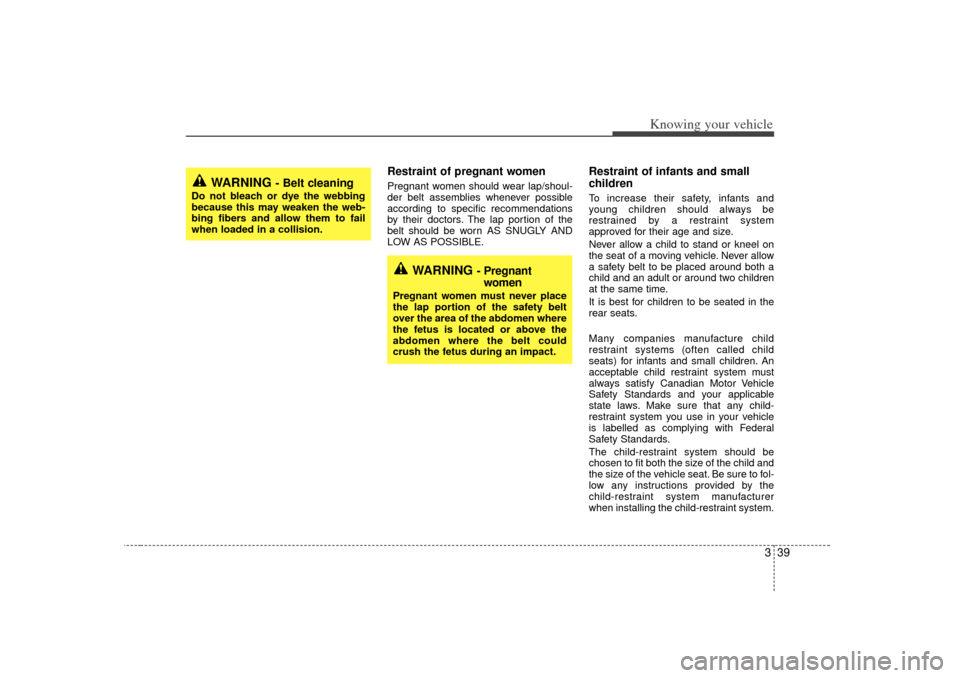
339
Knowing your vehicle
Restraint of pregnant women Pregnant women should wear lap/shoul-
der belt assemblies whenever possible
according to specific recommendations
by their doctors. The lap portion of the
belt should be worn AS SNUGLY AND
LOW AS POSSIBLE.
Restraint of infants and small
children To increase their safety, infants and
young children should always be
restrained by a restraint system
approved for their age and size.
Never allow a child to stand or kneel on
the seat of a moving vehicle. Never allow
a safety belt to be placed around both a
child and an adult or around two children
at the same time.
It is best for children to be seated in the
rear seats.
Many companies manufacture child
restraint systems (often called child
seats) for infants and small children. An
acceptable child restraint system must
always satisfy Canadian Motor Vehicle
Safety Standards and your applicable
state laws. Make sure that any child-
restraint system you use in your vehicle
is labelled as complying with Federal
Safety Standards.
The child-restraint system should be
chosen to fit both the size of the child and
the size of the vehicle seat. Be sure to fol-
low any instructions provided by the
child-restraint system manufacturer
when installing the child-restraint system.
WARNING
- Pregnantwomen
Pregnant women must never place
the lap portion of the safety belt
over the area of the abdomen where
the fetus is located or above the
abdomen where the belt could
crush the fetus during an impact.
WARNING
- Belt cleaning
Do not bleach or dye the webbing
because this may weaken the web-
bing fibers and allow them to fail
when loaded in a collision.